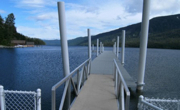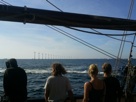 windmills outside Copenhagen
Reflections on a successful delivery of 8,000 bottles of wine, Holland to Denmark At this writing, the Tres Hombres schooner-brig is just reaching the Netherlands, on its way back from Copenhagen. I wish I had taken the round trip and remained with my able crew mates, but I had to keep to my sail-transport research schedule by returning to the Mediterranean. This we are sure of: as petroleum dependence continues to wreak havoc on our Earth’s sensitive environment, and the energy alternatives do not comprise an immediate solution, sail power emerges as the most viable energy source for trade and travel. 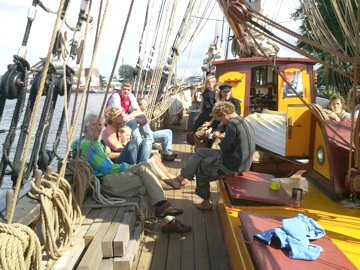 Waiting for the tugboat, Den Helder; Jan far left
The advent of zero-to-low-carbon transport is only "new" when consciously pursued as a step beyond petroleum. Traditional Indonesian sailing vessels, sporting low-tech/low-cost features, are only doing what is practical. The modern energy-intensive world’s version is to create new projects with an eye to the new Age of Sail. Prior to sailing to Copenhagen with French wine, Netherlands-based Fair Transport had its 32-meter schooner-brig Tres Hombres, complete an engineless delivery of 28,000 Grenada chocolate bars to Holland. In the Caribbean, an additional, unanticipated spare cargo space materialized. So cacao spiked with toasted sea salt was picked up on Hispañola. This unanticipated cargo was due to U.S. intransigence on accepting the Grenada bars in New York Harbor because the vessel and crew were foreign -- even though there was a U.S. customer and the delivery would have been very low-carbon. The U.S. public needs to clamour for a more rational approach, or wait until necessity ushers in the new Age of Sail. 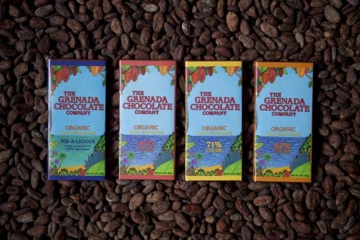 Chocolate from Grenada via Tres Hombres/Fair Transport
How did the chocolate bars not melt in the tropics? Answer: a refrigerated cargo hold, cooled on board primarily by solar-panel and wind-turbine power, keeps the bars solid until seawater temperature gets down to at least 16 degrees centigrade further north. This is an example of how Fair Transport gets the job done, illustrating that it deserves more cargo business and more passenger-trainees to support growing operations. How about an additional ship serving more ports and regions? The more the merrier, and the quicker the "sea change" that must come for trade and travel. Bunker fuel and jet fuel may be convenient, but their cost and damage are ushering them into history's trash bin. To rise to the occasion, Fair Transport has four certified sea captains, one of its strengths. This is the model for global sail transport success: expanding an organization’s expertise along with business. 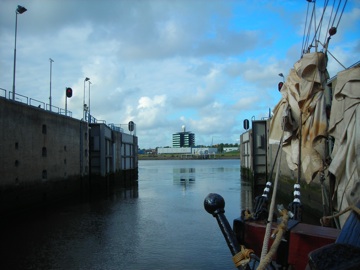 lock opens for Tres Hombres - photo by Ineke P.
But first, any needed maintenance and materials for the Tres Hombres constitute a worthy objective today for anyone who wants to see more sail transport. Fair Transport has a business plan for constructing an "ecoliner" vessel -- "Fair Winds" would be 8000 tons, length 135 m, masts 62 meters. It would use "dyna-rig" computer-adjustable sails for cargoes many times larger than the two-digit-ton loads so far on the Tres Hombres. So, in addition to contributing to the tall ship’s next replacement mast, or switching any synthetic materials for natural fibers, supporters may have suggestions or resources to offer for Fair Transport's ecoliner. Meanwhile, in the UK, the well-established renewable energy firm B9 Energy is rapidly progressing with its own ecoliner. Recent model-testing for the prototype vessel came back positive, according to the director of B9's subsidiary B9 Shipping, Diane Gilpin. The firm’s goal with the ship is to address the needs of its own renewable-energy municipal waste business, and offer both the vessel’s design and manufactured ships to prospective customers.
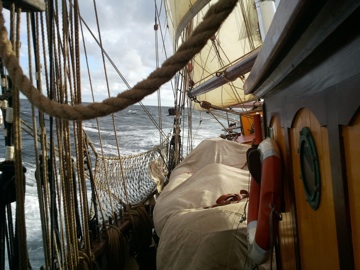 Plunging and bobbing along at 9 knots in the North Sea
Linked, Local Bioregionalism There are only a few other serious projects being developed for conscious sail transport in the world. They appear to be based in Europe, with the exception of Seattle's Sail Transport Company that is building a 50-foot cargo ketch. The U.S. lags way behind, despite the ongoing efforts of the Sail Transport Network established in 1999 in the Pacific Northwest. Thus it is for innovative-minded visionaries sensing the demise of the oil economy – well underway – to lead the way to the new world economy based on linked, local bioregionalism. Whether we prefer corporate globalism or we look forward to "relocalizing," sharply reduced world trade based on dwindling, climate-changing oil is inevitable. So only one’s immediate ecosystem determines the extent of product choice – but for that which is to be sailed in. We can muse on this future, but time is of the essence, as the planet warms and there is no scalable, ready alternative to the grossly high-volume oil-based transport. So this appeal to support Fair Transport is extended to include Sail Transport Network’s home office. If you would like to see more projects spotlighted and generated, please spread the word that donations are needed.
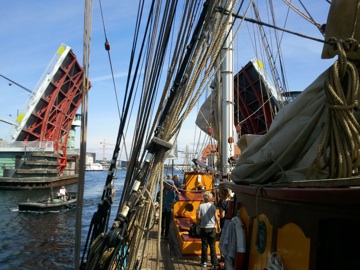 This is the fourth bridge that jammed or broke for Tres Hombres
We are committed to pursue sail transport for humanity and all species. On a personal note, I have jumped out into the thick of it – the world of a hands-on sail transport network, albeit not yet extensive, led by the good ship Tres Hombres. Why have I done this, when I could comfortably stay home and write another book, and spare myself the wear and tear of constant travel for seven weeks? It is because one’s devotion to an ideal or vision means seeking out living examples. To really learn about communes, for example, go visit them – online research cannot be three-dimensional, and there is no substitute for meeting fellow travellers in one’s chosen life’s work. I have been concentrating on sail transport nearly full time for almost two years. But an exponential realization was necessary for me, and now I can serve as a witness for others needing a glimpse of existing models and plans. One of the stops the Tres Hombres made in Copenhagen's harbor was to drop off cases of wine at Noma, reputed to be the greatest restaurant in the world. As we tied up to the dock, waiters brought us plates of award-winning fresh baked bread and prosciutto. Our crew got a tour of Noma (see my photo from within Noma). The restaurant shares its building with the Iceland Embassy and the Greenland Ministry. Funky yacht people including the low-cost floating hostel Haliwa are docked there, so it's no wonder the area is designated for a fancy development that will exclude present locals. It is part of a pattern that has eliminated scores of traditional sailing ships from Copenhagen's prominent central docks. And a new bridge threatens to block tall masts.
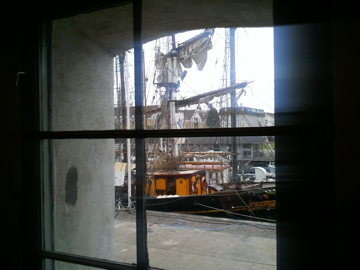 From Noma restaurant interior
I made this European trip as a networker from mid July to early September. The voyage to Copenhagen was an unanticipated, fabulous opportunity. Having been a blue-water sailor on small boats, I have now gotten my feet wet about the rigging and other systems of a tall ship. Living two weeks on the Tres Hombres, one week of it bounding over blue water, has been invaluable to me. Even more important than the knowledge and skill involved in the way such a ship is run is the communal (crew) aspect that maximizes the knowledge and skill for mutual benefit and survival. The Fair Transport/ Tres Hombres organization is a pleasure to interact with. One feels part of a greater, collective purpose – this is the open secret of their success to date. They are not yet making money hand-over-fist, but this can change overnight in today’s oil-vulnerable world. 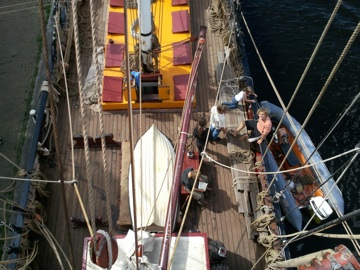 view from first level of squaresail mast
Probably the biggest boost in my own efforts to expand the sail transport movement has been to spend time face to face with Fair Transport and B9 Shipping. If I can personally serve, or see Sail Transport Network serve, these top global players as the new Age of Sail dawns, this may be how the post-petroleum future may be brought to the world’s attention all the sooner.
For donating to Fair Transport, please use PalPal by inserting the email address martinusromer "at" hotmail.com. Or mail a U.S.-dollar tax-deductable donation payable to GVI/Fair Transport, c/o
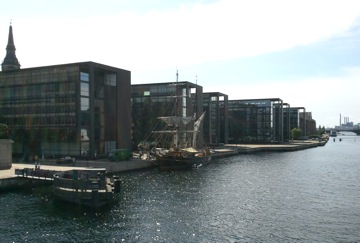 Biggest Scandinavian bank dwarfing Tres Hombres
To donate to Sail Transport Network, administered by Culture Change, please use the secure online webpage donation page, or mail a tax-deductible check payable to * * * * * Further reading: Sailing 8,000 bottles of wine to Copenhagen on the brigantine Tres Hombres of Holland, Aug. 4th, by Jan Lundberg
"The Grenada Chocolate Company has teamed up with The Tres Hombres to be the first to deliver chocolate bars across the ocean from the tropics to Europe." - read the story on the Tres Hombres' job for the Tres Hombres sails close to the wind - Update from the North Sea, Logbook Tres Hombres, August 8, 2012, by Jan Lundberg Skagerrak Strait, rounding Denmark, Logbook Tres Hombres, August 9, 2012, by Jan Lundberg
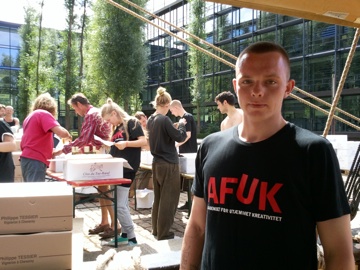 wine unloaders included Academy for Untamed Creativity
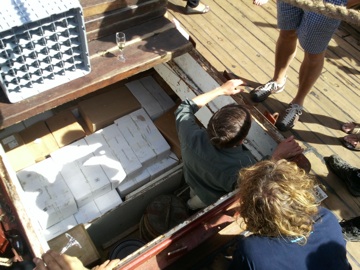 Roxforth's Sune unloads his wine from the cargo hold
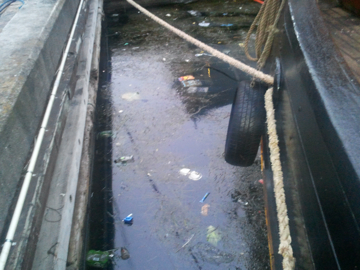 Copenhagen harbor corner with a concentration of plastic debris
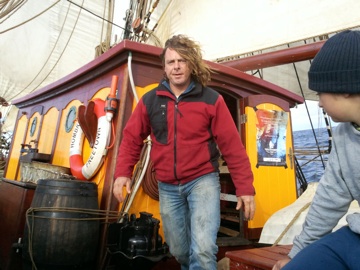 The intrepid Captain Jaap of Tres Hombres
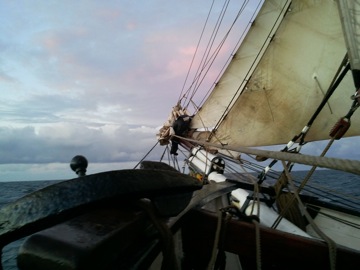 Jibs at work, with a sailor at end of bow
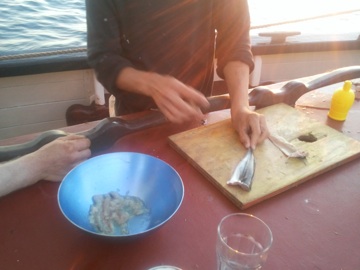 fresh caught mackerel from trolling
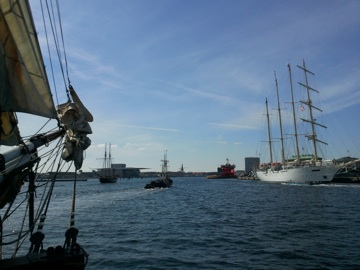 entering Copenhagen, with a Star Clipper on starboard
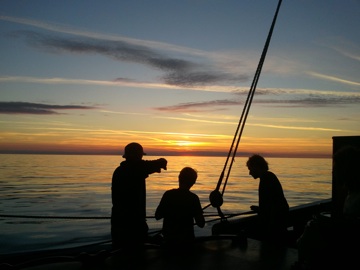 Sunset on a becalmed strait, Sweden off to east
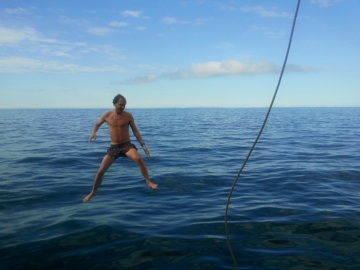 another becalmed day, and Ronald takes advantage
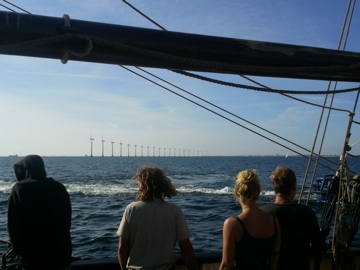 Approaching Copenhagen. Beyond windmills is Europe's longest bridge, to Sweden
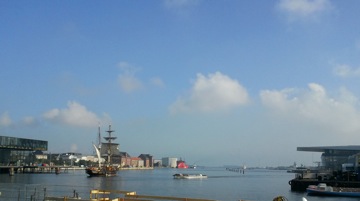 The Tres Hombres sails away from Copenhagen, Aug. 17. Theater building, left; Maersk's opera house, right
  |
|||
 |
||
|
|
